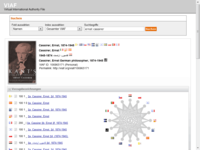Virtual International Authority File
 Screenshot 2012 | |
| Acronym | VIAF |
|---|---|
| Organisation | OCLC |
| Introduced | 6 August 2003 |
| Example | 106965171 |
| Website | viaf |
The Virtual International Authority File (VIAF) is an international authority file. It is a joint project of several national libraries and operated by the Online Computer Library Center (OCLC).[1]
History
Discussion about having a common international authority started in the late 1990s. After a series of failed attempts to come up with a unique common authority file, the new idea was to link existing national authorities. This would present all the benefits of a common file without requiring a large investment of time and expense in the process.[2]
The VIAF concept was introduced at the 2003 World Library and Information Congress, hosted by the International Federation of Library Associations.[3] The project was initiated by the US Library of Congress (LC), the German National Library (DNB) and the OCLC on 6 August 2003.[4][5] The Bibliothèque nationale de France (BnF) joined the project on 5 October 2007.
The project transitioned to being a service of the OCLC on 4 April 2012.[6]
The aim is to link the national authority files (such as the German Name Authority File) to a single virtual authority file. In this file, identical records from the different data sets are linked together. A VIAF record receives a standard data number, contains the primary "see" and "see also" records from the original records, and refers to the original authority records. The data are made available online and are available for research and data exchange and sharing. Reciprocal updating uses the Open Archives Initiative Protocol for Metadata Harvesting (OAI-PMH) protocol.
The file numbers are also being added to Wikipedia biographical articles and are incorporated into Wikidata.[7][8]
Christine L. Borgman groups VIAF with the International Standard Name Identifier and ORCID systems, describing all three as "loosely coordinated efforts to standardize name forms".[9] Borgman characterizes all three systems as attempts to solve the problem of author name disambiguation, which has grown in scale as the quantity of data multiplies.[9] She notes that VIAF, unlike the other two systems, is led by libraries, as opposed to individual authors or creators.[9]
VIAF clusters
VIAF's clustering algorithm is run every month. As more data are added from participating libraries, clusters of authority records may coalesce or split, leading to some fluctuation in the VIAF identifier of certain authority records.[10]
Participating libraries and organizations
Libraries added for testing purposes
| English Wikipedia entry name | Identifier | Native-language name | Location | Country |
|---|---|---|---|---|
| Lithuanian National Library | LIH | Template:Lang-lt | Vilnius | Lithuania |
| National and University Library of Slovenia / COBISS | SIMACOB | Template:Lang-sl | Ljubljana | Slovenia |
See also
- Authority control
- Faceted Application of Subject Terminology (FAST)
- Integrated Authority File (GND)
- International Standard Authority Data Number (ISADN)
- International Standard Name Identifier (ISNI)
- Wikipedia's authority control template for articles
References
- ^ Kelley, Michael; Schwartz, Meredith (2012). "VIAF service transitions to OCLC". Library Journal. 137 (8). Media Source Inc.: 16.

- ^ O'Neill, Edward T. (12 August 2016). "VIAF: Origins". Authority Data on the Web, a Satellite Meeting of the 2016 IFLA World Library and Information Congress. OCLC. Archived from the original (Video presentation) on 13 July 2018.
- ^ Loesch, Martha Fallahay (28 February 2011). "The Virtual International Authority File". Technical Services Quarterly. 28 (2): 255–256. doi:10.1080/07317131.2011.546304. ISSN 0731-7131. S2CID 62694070.
- ^ Morris, Susan R. (September 2003). "Virtual International Authority". Library of Congress Information Bulletin. Library of Congress. Retrieved 5 January 2021.
{{cite web}}: CS1 maint: url-status (link) - ^ Agnew, Grace (2008). Digital Rights Management: A Librarian's Guide to Technology and Practise. Chandos Publishing. p. 180. ISBN 978-1-84334-125-3. OCLC 62715356.
- ^ Murphy, Bob (4 April 2012). "Virtual International Authority File service transitions to OCLC; contributing institutions continue to shape direction through VIAF Council" (Press release). OCLC. Dublin, OH.
- ^ Klein, Max; Renspie, Melissa (7 December 2012). "VIAFbot Edits 250,000 Wikipedia Articles to Reciprocate All Links from VIAF into Wikipedia". OCLC.
- ^ Klein, Maximilian; Kyrios, Alex (14 October 2013). "VIAFbot and the Integration of Library Data on Wikipedia". The Code4Lib Journal (22). ISSN 1940-5758.
- ^ a b c Borgman 2015, p. 260.
- ^ Hickey, Thomas B.; Toves, Jenny A. (July 2014). "Managing Ambiguity In VIAF". D-Lib Magazine. 20 (7/8). Corporation for National Research Initiatives. doi:10.1045/july2014-hickey.
- ^ MacEwan, Andrew (12 August 2016). "ISNI and VIAF". Authority Data on the Web, a Satellite Meeting of the 2016 IFLA World Library and Information Congress. OCLC. Archived from the original (Video presentation) on 13 July 2018.
- ^ "NACO - Name Authority Cooperative Program". Library of Congress.
Sources
- Borgman, Christine L. (2015). Big Data, Little Data, No Data: Scholarship in the Networked World. MIT Press. ISBN 978-0-262-32786-2. OCLC 900409008.
External links
 VIAF ID (P214) (see uses)
VIAF ID (P214) (see uses)
